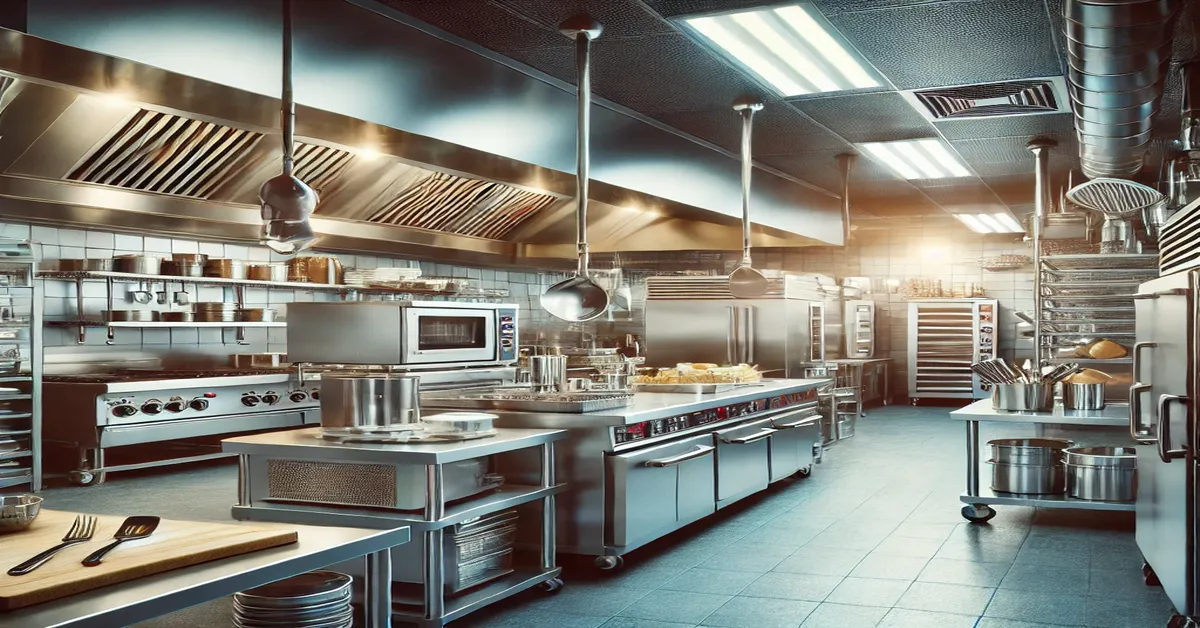In the fast-paced world of food service, the backbone of any successful operation is its kitchen. A restaurant’s kitchen is not just a place where food is cooked; it’s a well-oiled machine that needs to function smoothly and efficiently. To achieve this, investing in the right commercial kitchen equipment is essential. Whether you’re opening a new restaurant, upgrading your existing kitchen, or expanding your business, understanding the different types of restaurant equipment available and their uses is critical.
This comprehensive guide will explore various types of commercial kitchen equipment, their significance, and key considerations when purchasing them. We’ll delve into everything from cooking appliances to refrigeration, storage solutions, preparation tools, and cleaning equipment—making it easier for restaurant owners and chefs to make informed decisions.
1. Cooking Equipment: The Heart of the Kitchen
Cooking equipment is undoubtedly the most crucial part of any restaurant kitchen. Without the right tools, it’s impossible to prepare the diverse array of dishes required in a commercial kitchen. Let’s break down the essential cooking equipment:
a. Ranges and Ovens
Commercial ranges are the workhorses of any restaurant. They come in gas, electric, or induction varieties, each with its advantages. Gas ranges are popular due to their precise heat control and fast temperature adjustment, while electric ranges offer consistent heat distribution. Induction ranges, though more expensive, are energy-efficient and provide rapid heat.
Ovens are equally important, and they come in various forms:
- Convection ovens: These are designed to cook food evenly by circulating hot air inside the oven, making them ideal for baking and roasting.
- Deck ovens: Often used in bakeries and pizzerias, they provide high heat and cook food directly on the oven’s deck.
- Combi ovens: These versatile appliances can combine steam and convection cooking, allowing for a range of cooking techniques in one machine.
- Microwave ovens: Essential for quick reheating or defrosting tasks in high-demand environments.
b. Griddles, Grills, and Broilers
For restaurants specializing in grilled or seared dishes, commercial grills are essential. Charbroilers are commonly used to create that iconic charred flavor and are perfect for steaks, burgers, and vegetables.
Griddles offer a flat, heated surface, ideal for cooking breakfast items like pancakes, eggs, and bacon. They are also great for toasting buns or preparing grilled sandwiches.
Broilers, often referred to as salamanders, are high-heat devices used to quickly cook food or melt cheese on top of dishes. They are perfect for finishing steaks or adding a crispy top layer to casseroles.
c. Fryers
Fryers are indispensable in many restaurant kitchens, especially those specializing in fast food or fried items like fries, chicken, or seafood. Commercial fryers come in various capacities and styles:
- Deep fryers: Submerge food in hot oil for crispy results.
- Countertop fryers: Ideal for small operations with limited space.
- Pressure fryers: Use pressure to cook food faster and with less oil absorption, great for fried chicken.
d. Steamers
Commercial steamers are used for preparing healthier meals, especially vegetables and seafood. By using steam to cook food, they help retain nutrients and flavor without the need for added fats.
e. Cooking Ranges and Hot Plates
These compact and flexible cooking surfaces are crucial for smaller kitchens or for tasks that don’t require the full size of a range. They’re often portable, making them useful in catering or buffet setups.
2. Refrigeration Equipment: Keeping It Cool
In any commercial kitchen, refrigeration is key to maintaining food safety and freshness. Restaurants rely on various types of refrigeration equipment to store ingredients and prepared dishes at the right temperature:
a. Refrigerators and Freezers
Commercial refrigerators and freezers are built for heavy use and larger capacities compared to their residential counterparts. Depending on your kitchen’s needs, you may choose from the following types:
- Reach-in refrigerators and freezers: These are upright units with doors, similar to household models but larger. They’re easily accessible and come in different sizes based on capacity requirements.
- Walk-in coolers and freezers: Designed for high-volume operations, these provide ample space for storing perishable goods.
- Undercounter refrigerators: These are perfect for small kitchens or areas where space is limited. They offer easy access to chilled ingredients without taking up floor space.
- Prep tables with refrigeration: Used in sandwich shops or pizzerias, these units combine a workspace with built-in refrigerated storage.
b. Blast Chillers
Blast chillers rapidly cool hot food to a safe temperature, preventing bacterial growth. This is essential for restaurants that prepare large quantities of food in advance or need to store cooked dishes for later service.
c. Ice Machines
An often-overlooked piece of equipment, ice machines are essential for restaurants serving cold beverages or cocktails. They ensure a steady supply of ice, whether it’s cube, crushed, or flaked ice, depending on your specific needs.
3. Food Preparation Equipment: Streamlining the Process
Preparing food efficiently and consistently is crucial in a commercial kitchen. Food prep equipment helps reduce manual labor, saves time, and ensures that food is prepared to the same high standard every time.
a. Mixers
Whether you’re making bread, dough, or batter, commercial mixers are a necessity in bakeries, pizzerias, and restaurants. Stand mixers come in various sizes, from small countertop models to large floor mixers for high-volume operations.
b. Food Processors
A commercial food processor is one of the most versatile tools in the kitchen. It can chop, slice, dice, shred, and puree ingredients quickly, making it invaluable for prepping vegetables, sauces, and soups.
c. Slicers
Meat slicers are designed to cut through large quantities of meat quickly and evenly. They are ideal for delis and sandwich shops where high-volume slicing is necessary.
d. Blenders and Juicers
Restaurants that serve smoothies, soups, or sauces often rely on commercial blenders to create smooth, consistent textures. Juicers, on the other hand, are essential for juice bars or any establishment that serves fresh juices.
e. Cutting and Chopping Equipment
In addition to the above machinery, tools like mandolines, choppers, and vegetable dicers help ensure consistency in the size and shape of ingredients, reducing preparation time and improving presentation.
4. Storage Equipment: Organization is Key
In any busy restaurant kitchen, space is often at a premium. Proper storage equipment helps maximize available space, keep ingredients fresh, and improve workflow.
a. Shelving and Racks
Proper shelving and storage racks help organize kitchen equipment, dry goods, and non-perishables. Stainless steel shelving is preferred due to its durability and ease of cleaning. Ingredient bins or food storage containers also help keep products organized and easy to access.
b. Speed Racks
These are specifically designed to hold multiple sheet pans and are ideal for bakeries or high-volume kitchens where large quantities of baked goods or prepped foods need to be stored or transported efficiently.
c. Utility Carts
Utility carts are used to transport heavy equipment, ingredients, or dishes around the kitchen. They come in various sizes and are made from durable materials like stainless steel or plastic.
5. Dishwashing and Cleaning Equipment: Maintaining Hygiene
A restaurant’s reputation depends not only on its food but also on the cleanliness and hygiene maintained in the kitchen. The right cleaning equipment ensures that your kitchen operates efficiently while adhering to food safety standards.
a. Commercial Dishwashers
In a high-volume kitchen, a commercial dishwasher is essential. There are different types based on the size and needs of the establishment:
- Undercounter dishwashers: Suitable for smaller kitchens, they fit beneath the counter and can wash multiple loads of dishes throughout the day.
- Door-type dishwashers: Larger and more powerful, these can handle more significant volumes of dishwashing, often found in mid-sized to large kitchens.
- Conveyor dishwashers: These are high-capacity machines ideal for large-scale operations, capable of washing hundreds of racks per hour.
b. Sinks and Faucets
Commercial kitchens are required to have specific types of sinks to comply with health regulations. These include:
- Handwashing sinks: Essential for employee hygiene.
- Three-compartment sinks: Required for washing, rinsing, and sanitizing dishes when a dishwasher isn’t available.
- Mop sinks: Used for filling and emptying mop buckets to keep floors clean.
c. Grease Traps
Grease traps are essential for collecting grease, fats, and oils that might clog the kitchen’s drainage system. These devices help prevent sewer backups and ensure compliance with local waste management regulations.
d. Cleaning Supplies and Tools
To maintain a clean and safe kitchen environment, restaurants need an array of cleaning tools, including mops, brooms, scrubbers, and cleaning chemicals that meet health and safety standards.
6. Ventilation Systems: A Breath of Fresh Air
Proper ventilation in a commercial kitchen is not only a regulatory requirement but also essential for the health and safety of the kitchen staff. Grease, smoke, and steam can accumulate during the cooking process, making the kitchen environment dangerous and uncomfortable.
a. Exhaust Hoods
Exhaust hoods are installed over cooking appliances to capture and filter smoke, steam, and grease particles. They keep the kitchen air clean and prevent the build-up of hazardous fumes.
b. Make-up Air Units
These systems replace the air removed by the exhaust hood, maintaining balanced air pressure in the kitchen. Without proper air replacement, the kitchen may become too hot or develop unpleasant odors.
7. Specialty Equipment: Catering to Niche Needs
In addition to standard kitchen equipment, many restaurants also require specialty equipment to cater to their specific menu items or service styles. This can include items such as:
- Pizza ovens: These ovens are designed to reach high temperatures to create the perfect pizza crust.
- Sous-vide machines: Ideal for precise cooking, sous-vide machines help chefs maintain exact temperature control for extended periods.
- Warming cabinets: Keep prepared food at a safe serving temperature, ideal for catering or banquet-style service.
Conclusion: The Right Equipment, The Right Investment
Choosing the right commercial kitchen equipment is a significant investment that will impact the efficiency, productivity, and profitability of your restaurant. Understanding the different types of equipment available and how they fit into your kitchen’s workflow is crucial for creating a successful operation.
From the essential cooking ranges and refrigeration units to specialized food prep tools and cleaning systems, every piece of restaurant equipment plays a vital role in the day-to-day functioning of your business. When investing in your kitchen, focus on the quality, durability, and suitability of each piece for your specific needs.
In the end, a well-equipped kitchen not only supports your staff in delivering exceptional food but also enhances your restaurant’s reputation for efficiency, safety, and quality service.







